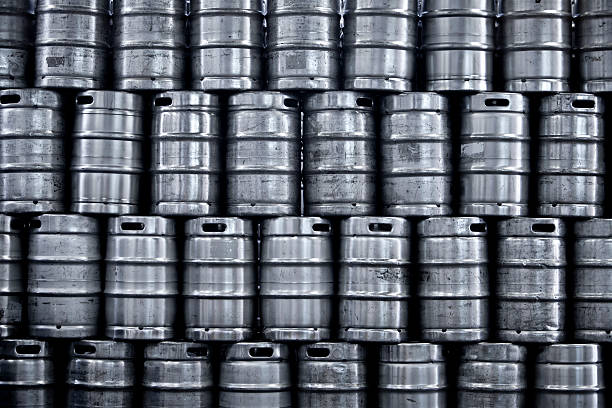Embarking on the quest to understand the heft of a keg leads one into the heart of brewing culture and logistics, a journey as rich and varied as the brews themselves. The article titled “How Much Does A Keg Weigh” is your essential guide through this exploration, meticulously crafted by experts who bring decades of brewing and beverage industry experience to the table. This piece doesn’t just provide numbers; it offers a comprehensive look into the different types of kegs, their capacities, and, crucially, their weight – a fundamental yet complex topic that affects everyone from brewers to bar owners, and even party planners.
Understanding the weight of a keg is about more than just the physical effort required to lift or move it; it’s about planning, logistics, and safety. This article demystifies the various factors that contribute to a keg’s weight, including the materials from which kegs are made, the volume and type of beverage they contain, and the impact of these elements on transportation and storage practices. Whether you’re a professional in the beverage industry, a home brewer, or simply someone planning your next big event, knowing the ins and outs of keg weights is indispensable.
With an eye for detail and a knack for presenting complex information in an accessible manner, “How Much Does A Keg Weigh” promises to be an engaging read. It not only equips you with the practical knowledge needed to navigate the world of kegged beverages but also enriches your appreciation for the science and craftsmanship behind every pour. Prepare to lift the veil on one of the most taken-for-granted aspects of beverage service and management, and in doing so, elevate your understanding and enjoyment of your next kegged brew.
Understanding Keg Types and Sizes
- Full Keg (Half Barrel Keg): The full keg, also known as the half barrel, is the largest and most common keg size in the U.S. Weighing over 160 pounds when full, this bulky container holds 15.5 gallons or 124 pints of beer. With its impressive capacity, the full keg is a popular choice for large parties and events.
- 50 Liter Keg (Import Keg/European Barrel): While less common in the U.S., the 50 liter keg is ubiquitous in Europe. Slightly smaller than the American full keg, these imported barrels tip the scales at around 140 pounds full and contain 13.2 gallons or approximately 100 pints of brew. Thanks to their cosmopolitan flair, 50 liter kegs are a go-to for bars featuring overseas brews.
- Quarter Barrel Keg (Pony Keg): As the name suggests, the quarter barrel keg contains one fourth the volume of a full keg. Weighing over 80 pounds filled, these petite ponies hold around 40 pints or 7.75 gallons of suds. The slim quarter keg has a similar capacity in a narrower container. Both versions are manageable sizes for smaller get-togethers.
- Sixth Barrel Keg (Sixtel): Sixth barrel kegs are pint-sized party starters. Weighing in at over 35 pounds filled, these sixths contain approximately 5.2 gallons or 41 pints of brew. Their diminutive size makes sixtels workable for personal use.
- Cornelius Keg (Corny Keg/Mini Keg): Lastly, the Cornelius or corny keg is the mini cooper of kegs. These small 5 liter kegs are typically used for homebrewing. When filled, they weigh around 20 pounds and contain 1.3 gallons or just over 10 pints. Corny kegs provide an affordable kegging option for homemade brews.
Keg Deposit Fees and Return Policies
When getting kegs, a deposit is required upfront and refunded upon return of the empty keg and tap. Deposits average $50 for a full keg, $30 for a half barrel, $20 for a sixth, and $10 or less for a corny keg. Policies vary, but kegs are usually expected back within days to weeks after the brew is tapped. Failure to return kegs incurs lost deposits and possibly additional charges. Remember, keg returns are hassle-free ways to get your deposits back and avoid fees.
Transportation and Handling
Transporting kegs requires a bit of finesse. Full kegs can be cumbersome, so use carts, lifts, and helpers when moving them. Load and stack kegs securely, and brace them during transport to prevent shifting and damage. Always wear closed toe shoes when handling, and avoid dropping kegs which can cause leaks, dents, and injury. With some common sense, kegs can be moved safely and responsibly.
Keg Tap Types and Compatibility
To tap different keg types, compatible taps are required. Full kegs use thick Sankey D couplers, while import kegs utilize thinner S system taps. American sixths and pony kegs are tapped with A or M system couplings, and corny kegs use ball lock or pin lock connectors. Using mismatched taps will prevent proper sealing and dispensing of brews. When buying a keg, double check the tap style needed so your beer doesn’t get bottled up.
Maintenance and Cleaning
Diligent maintenance and cleaning are vital for kegs and equipment. Begin by triple rinsing kegs after emptying to prevent residue buildup. Periodically clean lines, faucets, and couplings with cleaner solution. Replace worn O-rings and poppets to maintain seals and flow. Quick cleanups after use prevents contamination and keeps beer tasting fresh. Sanitize kegs before refilling to store brews in pristine condition. Just a bit of care goes a long way.
Environmental Considerations
In our eco-conscious age, the sustainability of kegs versus cans and bottles comes into play. Kegs are reused far more times over their life span, lending an environmental edge over one-way cans and bottles. With reuse and recycling programs, kegs produce less waste for landfills. However, kegs do require energy for repeated transport and washing. Ultimately, kegs hold promise as sustainable options when handled responsibly.
Legal and Regulatory Considerations
There are a few legal aspects to keep in mind when using kegs. First, kegs cannot be legally resold without brewery approval, so obtain kegs directly from beverage suppliers. Next, unused deposits cannot be claimed as cash reimbursements but as future credits by law in some areas. Furthermore, keg registration programs aim to inhibit underage drinking by requiring ID and signatures to purchase kegs. Being mindful of regulations creates informed, responsible keg users.
Keg Storage Conditions
Proper storage is key to maximizing shelf life and quality. Full kegs should be stored cold at 33-38 °F to maintain freshness. Colder temperatures near freezing risk freezing lines and regulators. Storing kegs at room temperature accelerates staling issues. Keep kegs sealed when not dispensing, and do not tap until ready to serve. Optimal storage keeps beer tasting crisp until the last pour.
Frequently Asked Questions About Keg Sizes and Use
Are kegs more cost-effective than cans or bottles?
Kegs can offer savings over individual cans or bottles when purchased in bulk for large events or in repeat batches for ongoing use. However, kegs contain more beer than required for casual needs. For smaller occasions, cans or bottles may be more economical.
Can I use a keg in my home?
Absolutely. Mini kegs like sixtels or corny kegs are convenient sizes for home use. Be sure to also get compatible taps, regulators, tubing, and CO2 tanks. Follow safety guidelines for handling, and research your area’s regulations. With the right gear, kegs can be a draft lover’s dream.
Related posts: how many beers in a case
Conclusion
With this overview of keg types, sizes, care, and usage, you are equipped to tap into the dynamic world of kegs. From colossal full kegs to compact cornys, kegs offer versatile vessels for enjoying brews. Now that you know the ins and outs, it is time to get your tap lines ready and savor the adventures of keg life.

